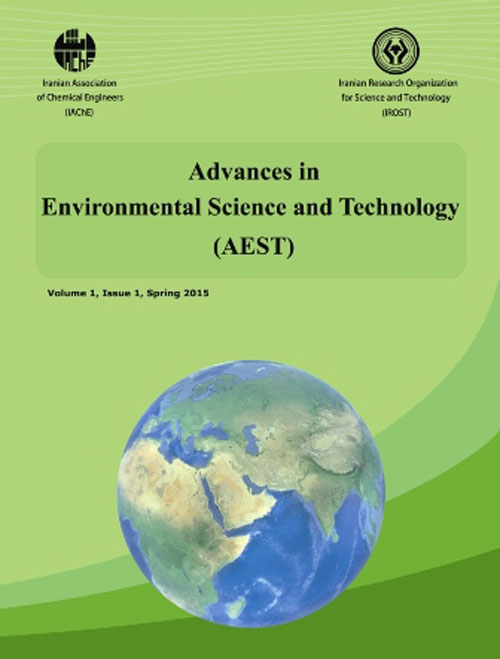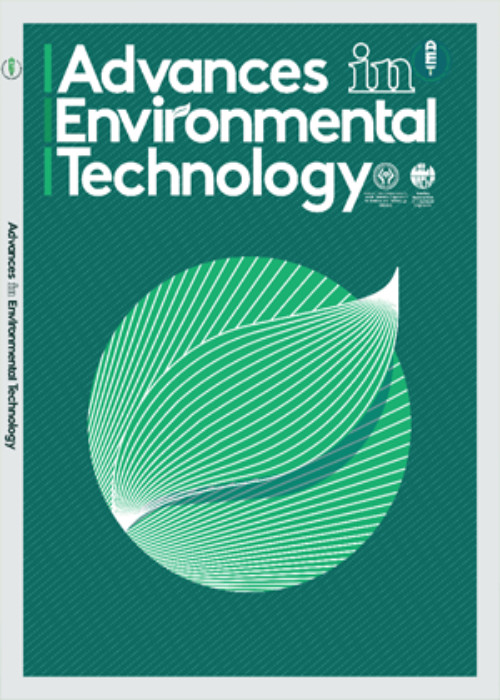فهرست مطالب

Advances in Environmental Technology
Volume:1 Issue: 1, Spring 2015
- تاریخ انتشار: 1394/01/18
- تعداد عناوین: 7
-
-
Pages 1-9The expansion of a microbial bank for the degradation of polycyclic aromatic hydrocarbons (PAHs) is crucial for removal of these persistent pollutants. In this study, five gram-negative, aerobic, non-fermentative bacterial strains (III-R3, IV-P11, IV-P13, IV-R13, and V-P18) were isolated from the activated sludge of a petrochemical wastewater treatment plant using enrichment pro tocol based on phenanthrene. The isolates were capable of utilizing phenanthrene, anthracene, and pyrene as a sole carbon and energy source in an aerobic batch aqueous system. The PAHs biodegradation yields were evaluated by gas chromatography and the bacterial isolates were identified using the 16S rRNA sequencing method. A first-order kinetic model provided the best fit to the phenanthrene degradation profiles with a correlation coefficient value of 0.95-0.98. The phenanthrene biodegradation rate constants and half-lives were measured at the range 0.653--Q.878 day-' and 0.79-1.06 day, respectively. Lower values of Anthracene degradation re sulted with the isolates of the current study, while a relatively high percentage of the removal of Pyrene was obtained by some of the isolates. The data obtained in this study shows that bacterial isolates have degradation preference over Mycobacterium sp. and Pseudomonas aeruginosa; and they are comparable with Pseudomonas stutzeri, Sphingomonas sp., and microbial consortium applied by other researchers. Analysis of the 16S rDNA gene sequence, when compared with the GenBank, indicates that all the strains belong to the genus Sphingopyxis with the nearest type strain being Sphingopyxis ummariensis Ul2 (MTCC 8591T). It is the first time that Sphingopyxis ummariensis is reported for its capability in the degradation of PAHs.Keywords: Polycyclic aromatic hydrocarbons (PAHs), Phenanthrene, Biodegradation, Kinetics, Sphingopyxis ummariensis
-
Pages 11-16The present study investigated the isolation and identification of biosurfactant producing bacteria from Iranian oil wells. The biosurfactant production of bacteria isolates was evaluated and confirmed using hemolysis and emulsification tests. The biodegradation of crude oil was studied using GC and HPLC analysis. A total of 45 strains have been isolated. These strains showed less than a 40 mN m-1 reduction in surface tension. The effects of different pH (4.2-9.2), salinity concentrations (1%-15%), and temperatures (25-50) in biosurfactant production of isolated strains were evaluated. One of the strains (Bacillus sp. NO.4) showed a high salt tolerance and a successful production of biosurfactant in a vast pH range. Its maximum biomass production (about 3.1 g L-1 dry weight) was achieved after 60 hours of growth. The surface tension of the culture broth dropped rapidly after inoculation and reached its lowest value (36 mN m-1) during the exponential phase after about 36-48 hours of growth. The study of the GC graphs showed that higher aliphatic reduction occurred in fractions with C14 to C24 hydrocarbons. The depicted results of the HPLC graphs indicated a 100% degradation of chrysene and fluorine. In this study, we demonstrated the useful capacities of the isolates in removing oil pollutants and their application in MEOR in vitro.Keywords: Indigenous, Biosurfactant, Bacteria, Crude oil
-
Pages 17-23In the present study, micellar-enhanced ultrafiltration (MEUF) was used to remove manganese (Mn) (II) from synthetic wastewater. The effects of different operational conditions on the filtration performance of MEUF or the membrane were studied. It was found that the transmembrane pressure has a major influence on the permeate flux and an insignificant effect on the rejection coefficient. The permeate flux increased almost linearly with operating pressure, ranging from 0.35 L min-1 m-2 at 1 bar to 1.79 L min-1 m-2 at 4 bar. When the pH of the feed solution was changed from 3 to 13, the permeate manganese concentration decreased considerably while the rejection of manganese increased from 75.37% to 99.78%. The results showed that by adding SDS anionic surfactant, the permeate flux and the removal efficiency of manganese increased. The retention of Mn (II) increases from 47% in the absence of SDS to around 97% with 10mM SDS. In this state, the MEUF system has a rejection of above 97 percent of manganese. The Mn rejection increased slightly with an increase of operating pressure, ranging from 89.658 at 1 bar to 97.971 at 4 bar. Adding NaCl to the solution provokes the complexation of metal cations with chloride ions and the adsorption competition of sodium cations with the metal ions; therefore, the conductivity increment decreases the metal retention. The presence of 60 mM of NaCl reduced the removal efficiency by 50–60%.Keywords: MEUF, Ultrafiltration, Manganese, SDS
-
Pages 25-30Carbon dioxide capture is a key issue in climate change mitigation. For decades the removal of carbon dioxide has been an essential step in many industrial processing operations such as the synthesis of ammonia, natural gas purification, and oil refining. In this study, a rotating packed bed has been designed for absorption of carbon dioxide from an air stream. The rotating packed bed is a compact device which can be used to replace the conventional absorption technology because of its high efficiency, compact size, and reduced weight. Experiments have been done for carbon dioxide absorption and the effect of parameters such as rotational speed, gas and liquid flow rates, and concentration of the MEA solution on the height of transfer unit investigated for different packing types. The results show that the height of transfer unit values for carbon dioxide absorption were 2.4~ 4 cm depending on the rotational speed, absorption solution concentration, and gas and liquid flow rates.Keywords: Rotating Packed Bed, Height of Transfer Unit, Mass Transfer, Absorption, Carbon Dioxide
-
Pages 31-40In this work, styrene removal from wastewater by using sugarcane waste (bagasse) as an adsorbent was studied. Equilibrium isotherms and kinetics were determined; the effects of bagasse particle size and concentration, solutions pH, and temperature on the biosorption of styrene were studied in batch experiments. Adsorption equilibrium data was successfully fitted to Langmuir isotherms (R2=0.986) and Freundlich isotherms (R2=0.96). Also, the kinetics of biosorption was fitted to pseudo-second order equations (K2=0.00146 g mg-1 min-1, qe=24.5 mg g-1 for particle size range of 88-105 μm). According to the obtained results, an empirical equation was presented that could be used to calculate the percentage of styrene adsorption. The results showed that an increase in temperature caused a decrease in styrene removal. Moreover, maximum uptake was observed with NaOH-treated bagasse. It was found that an increase in average particle size decreased the biosorption rate. According to the calculated heat of adsorption, this sorption can be classified as a chemical biosorption. The optimum uptake was determined to be 88% at a pH equal to 12.1, a temperature of 35 oC, a particle size of 420-500 μm, and a bagasse concentration of 1 g L-1.Keywords: Bagasse, Biosorption, Isotherm, Kinetic, Styrene
-
Pages 41-47The purpose of this study is to investigate the performance and efficiency of Moringa seeds from different sources on turbidity. A protein analysis test was done for each source; then two different methods of extraction were compared to examine the coagulation activity for the Moringa's active ingredient. The results of sodium chloride (NaCI) extraction in comparison to distilled water extraction of the Moringa olifera seeds showed that the salt solution extraction technique was more efficient than the distilled water for extracting the active coagulant ingredient. The above mentioned findings were used to examine the effects of other parameters such as pH, calcium and magnesium hardness, bicarbonate-alkalinity, and salinity independently on turbidity removal with an optimum dosage of 1% NaCI extract of dry shelled Moringa seeds. The obtained results showed that the water quality parameters had no significant effect on the coagulation potential of the NaCI extract of the shelled Moringa seeds and was almost amenable to a wide range of water environment condition.Keywords: Water Quality, Coagulation, Moringa Oleifera
-
Pages 49-58In some instances, it is inevitable that large amounts of potentially hazardous chemicals like chlorine gas are stored and used in facilities in densely populated areas. In such cases, all safety issues must be carefully considered. To reach this goal, it is important to have accurate information concerning chlorine gas behaviors and how it is dispersed in dense urban areas. Furthermore, maintaining adequate air movement and the ability to purge ambient from potential toxic and dangerous chemicals like chlorine gas could be helpful. These are among the most important actions to be taken toward the improvement of safety in a big metropolis like Tehran. This paper investigates and analyzes chlorine gas leakage scenarios, including its dispersion and natural air ventilation effects on how it might be geographically spread in a city, using computational fluid dynamic (CFD). Simulations of possible hazardous events and solutions for preventing or reducing their probability are presented to gain a better insight into the incidents. These investigations are done by considering hypothetical scenarios which consist of chlorine gas leakages from pipelines or storage tanks under different conditions. These CFD simulation results are used to investigate and analyze chlorine gas behaviors, dispersion, distribution, accumulation, and other possible hazards by means of a simplified CAD model of an urban area near a water-treatment facility. Possible hazards as well as some prevention and post incident solutions are also suggested.Keywords: Gas dispersion, Computational Fluid Dynamic, Chlorine gas, hazard simulation, Water, treatment facility


